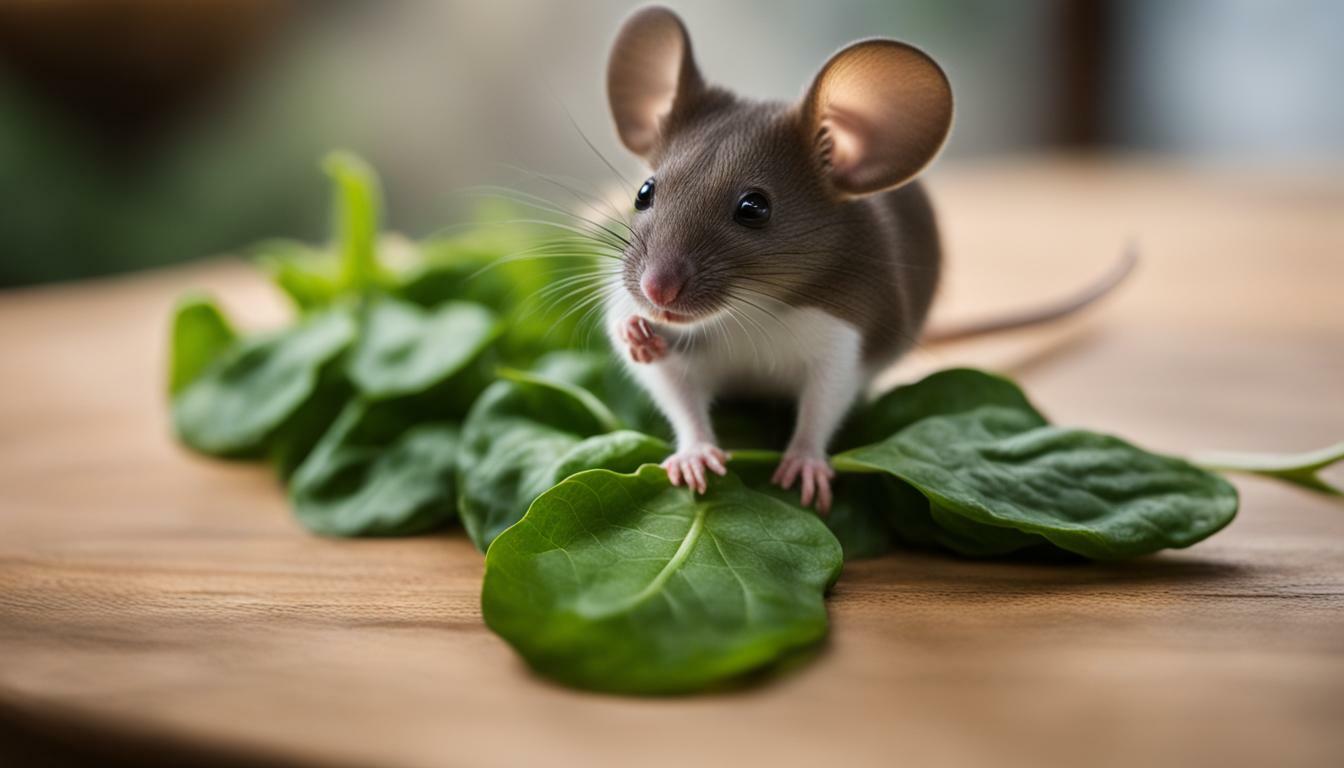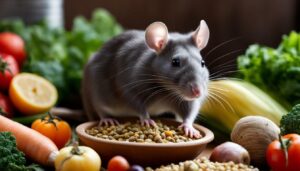Wondering if mice can safely consume spinach? Find out everything you need to know about incorporating this leafy green into your pet mouse’s diet.
Pet mice can eat spinach as part of their diet. Spinach is nutritious for mice as it is rich in vitamins A, K, C, and E, as well as minerals like iron, manganese, zinc, potassium, and calcium. However, it is important to feed spinach in moderation, as excess quantities can cause health issues such as kidney problems, dehydration, and diarrhea. Other leafy vegetables that mice can eat include kale, cabbage, watercress, parsley, and lettuce. It is recommended to introduce vegetables slowly into a mouse’s diet and consult a veterinarian for advice on the quantity and suitability of foods like spinach.
Key Takeaways:
- Spinach is safe for mice to consume, but it should be fed in moderation to avoid health issues.
- In addition to spinach, mice can also enjoy other leafy greens such as kale, cabbage, watercress, parsley, and lettuce.
- When introducing spinach or other vegetables to a mouse’s diet, do so gradually to monitor for any adverse reactions.
- Consult a veterinarian for specific dietary advice and guidance on incorporating spinach into a well-rounded and healthy diet for your pet mouse.
- Remember that each mouse may have individual dietary preferences, so it’s essential to observe and understand your mouse’s needs.
The Nutritional Benefits of Spinach for Mice
Spinach is not only a delicious treat for mice but also provides them with a range of essential nutrients for optimal health. This leafy green vegetable is packed with vitamins A, K, C, and E, which are vital for maintaining strong immune systems and promoting overall wellbeing. Additionally, spinach is rich in essential minerals such as iron, manganese, zinc, potassium, and calcium, which support various bodily functions.
These nutrients play a crucial role in supporting a mouse’s immune system, promoting healthy bone development, and aiding in proper blood clotting. Vitamin K, for example, is essential for mice as it helps prevent excessive bleeding and supports bone health. Meanwhile, the antioxidants present in spinach, like vitamins A and C, help protect mice from free radicals and cellular damage.
To ensure your mouse benefits from the nutritional advantages of spinach, consider incorporating it into their diet in moderation. While spinach is highly nutritious, feeding too much can lead to health issues like kidney problems, dehydration, and diarrhea. It is crucial to consult a veterinarian for guidance on the appropriate quantity of spinach for your mouse’s diet.

In addition to spinach, there are other leafy vegetables that mice can enjoy. Kale, cabbage, watercress, parsley, and lettuce are all suitable options that provide similar nutritional benefits. By offering a variety of these vegetables, you can ensure your mouse receives a well-rounded and balanced diet.
| Leafy Vegetables for Mice | Nutritional Benefits |
|---|---|
| Kale | Packed with vitamins A, C, and K, as well as minerals like calcium and potassium. |
| Cabbage | Rich in vitamin C and fiber, which aids in digestion. |
| Watercress | Contains vitamins A, B, C, and E, along with minerals like calcium and iron. |
| Parsley | High in vitamins A, C, and K, as well as iron and potassium. |
| Lettuce | Provides hydration and contains vitamins A, C, and K. |
When introducing vegetables to your mouse’s diet, do so gradually to allow their digestive system to adjust. Observe your mouse for any signs of adverse reactions and consult a veterinarian if you have any concerns.
Remember, each mouse is unique, and their dietary preferences may vary. While some mice may enjoy spinach, others may prefer different leafy greens. Understanding your mouse’s individual needs and preferences will help you provide them with a well-balanced diet that supports their overall health and happiness.
Moderation is Key: How Much Spinach to Feed Mice
While spinach can be a nutritious addition to a mouse’s diet, it’s crucial to offer it in the right amounts to avoid any potential health risks. Spinach is packed with essential vitamins and minerals, including vitamins A, K, C, and E, as well as important minerals like iron, manganese, zinc, potassium, and calcium. These nutrients contribute to a mouse’s overall health and wellbeing.
However, feeding spinach to mice in excessive quantities can lead to health issues such as kidney problems, dehydration, and diarrhea. It’s important to remember that moderation is key when it comes to incorporating spinach into a mouse’s diet. The exact amount of spinach to feed will vary depending on the mouse’s size, age, and overall health.
To determine the appropriate quantity, it is highly advisable to consult a veterinarian who specializes in small animals. A veterinarian can provide expert guidance on the suitable amount of spinach to feed your mouse, taking into account its individual needs and dietary requirements. They can also offer recommendations on other leafy vegetables that can be included in a well-rounded diet for your mouse.
| Serving Size | Frequency |
|---|---|
| 1 teaspoon | 2-3 times per week |
Remember, it’s always best to introduce new foods gradually into a mouse’s diet. This allows their digestive system to adjust and helps prevent any potential stomach upset. Keep a close eye on your mouse’s behavior and stool consistency when introducing spinach or any other new food. If you notice any adverse reactions, it’s important to consult your veterinarian.
Feeding your mouse a varied diet that includes a mix of vegetables, fruits, and high-quality commercial mouse food is the key to providing them with a well-rounded nutrition. By offering a balanced diet and keeping spinach feeding in moderation, you can ensure the optimal health and happiness of your mouse.
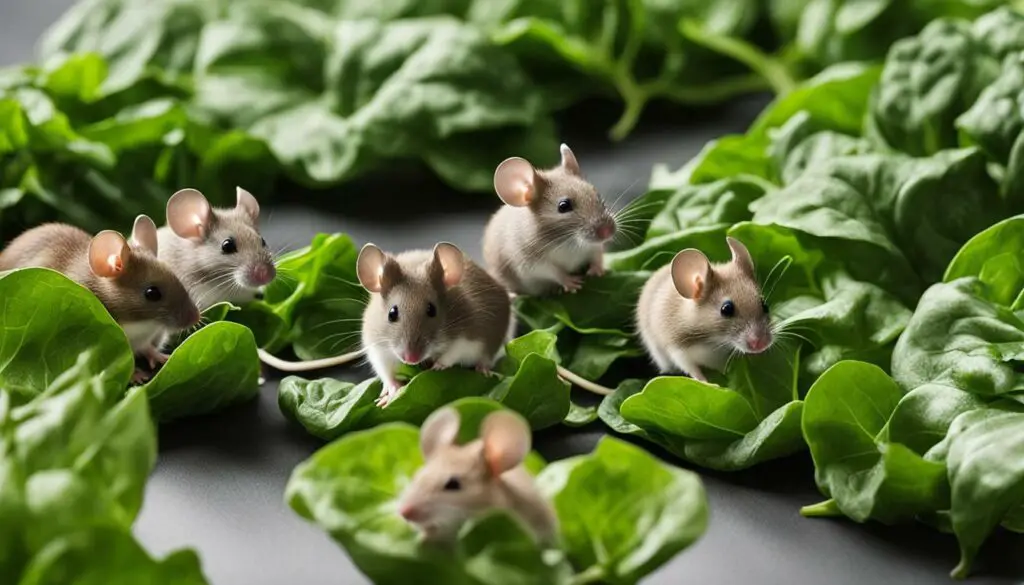
If your pet mouse isn’t a fan of spinach or you’re looking to diversify their leafy green options, here are a few other veggies to consider incorporating into their diet:
- Kale: Rich in vitamins A, C, and K, kale is a nutritious alternative to spinach for mice. It also contains minerals like calcium and iron.
- Cabbage: This crunchy vegetable is packed with vitamins K and C, as well as fiber, making it a great addition to a mouse’s diet.
- Watercress: Not only is watercress low in calories, but it also provides vitamins A, C, and K, as well as minerals like calcium and iron.
- Parsley: Aromatic and flavorful, parsley offers vitamins A, C, and K, as well as minerals including calcium and potassium.
- Lettuce: With its high water content, lettuce helps hydrate mice, and it also provides vitamins A and K alongside fiber.
These alternatives to spinach can be served fresh and raw, ensuring mice receive the maximum nutritional benefits. Remember to introduce new foods gradually and observe your mouse’s response to ensure they tolerate and enjoy the new additions to their diet. If you have any concerns or questions, it’s always a good idea to consult a veterinarian for guidance tailored to your individual pet.
| Veggies | Nutritional Benefits |
|---|---|
| Kale | Vitamins A, C, and K, calcium, iron |
| Cabbage | Vitamins K and C, fiber |
| Watercress | Vitamins A, C, and K, calcium, iron |
| Parsley | Vitamins A, C, and K, calcium, potassium |
| Lettuce | Vitamins A and K, fiber |
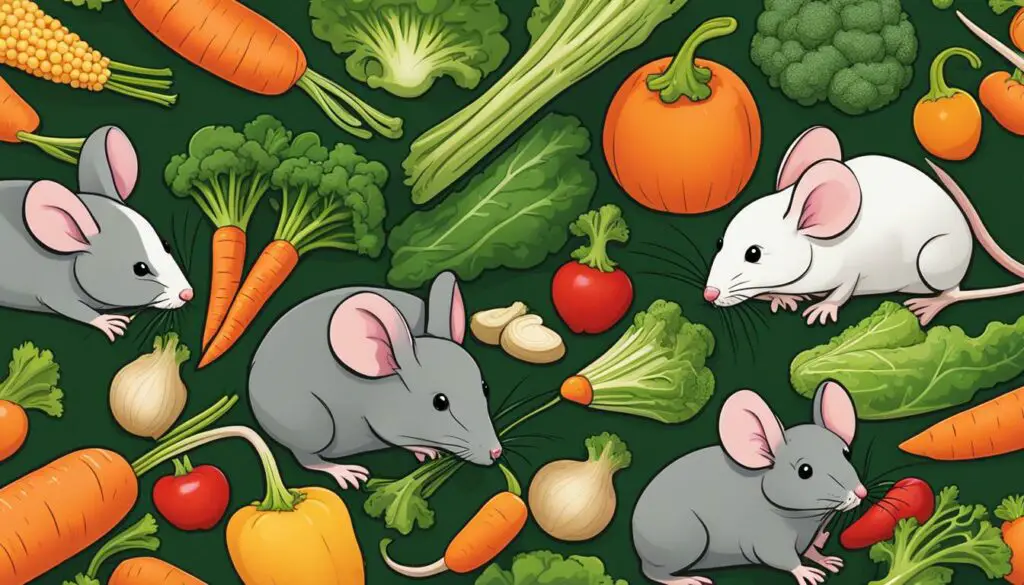
Introducing Vegetables to a Mouse’s Diet
Introducing new foods into your mouse’s diet, including spinach, requires a patient and gradual approach to ensure their digestive system adjusts smoothly. Mice are naturally curious creatures, so it’s important to provide them with a varied and nutritious diet. Spinach, with its abundance of vitamins and minerals, can be a great addition to their meal plan, but it should be introduced slowly to prevent any stomach upset.
Start by offering small pieces of spinach alongside their regular food. Observe how your mouse responds to the new addition and monitor their digestion. If they show no signs of discomfort or adverse reactions, you can gradually increase the amount of spinach in their diet. Remember, moderation is key when feeding mice spinach or any other food.
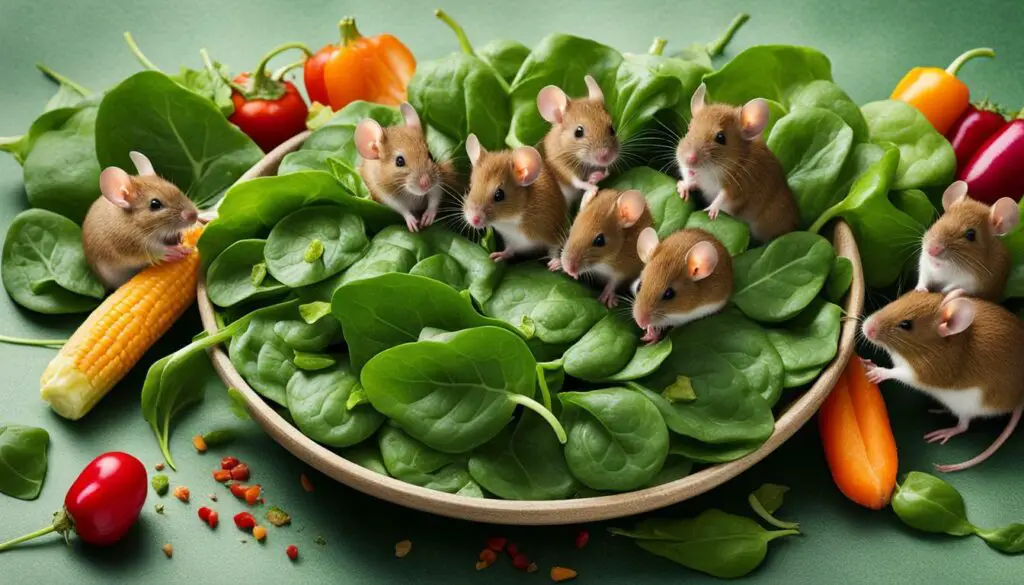
| Benefits of Feeding Spinach to Mice |
|---|
| 1. Rich source of vitamins A, K, C, and E |
| 2. Provides essential minerals like iron, manganese, zinc, potassium, and calcium |
| 3. Supports immune system health |
| 4. Promotes strong bones and teeth |
It’s important to note that each mouse is unique, and while some may enjoy spinach, others may have different preferences. If your mouse doesn’t seem interested in spinach, you can offer alternative leafy vegetables like kale, cabbage, watercress, parsley, or lettuce. These options also provide nutritional benefits and can add variety to their diet.
Consulting a Veterinarian for Dietary Advice
If you have any concerns or questions about feeding spinach to your mouse, it’s always best to consult a veterinarian. They can provide specific dietary advice tailored to your mouse’s individual needs. Veterinarians are experienced in creating well-rounded and healthy diet plans for your pet mice, ensuring they receive the necessary nutrients for optimal health.
Consulting a Veterinarian for Dietary Advice
To ensure your mouse’s diet is as balanced as possible, it is recommended to seek professional guidance from a veterinarian who can provide tailored advice based on your mouse’s individual needs. A veterinarian specializing in small animals will have the expertise to create a well-rounded diet plan for your pet mouse, including recommendations on incorporating spinach and other leafy greens.
When consulting a veterinarian, it is helpful to provide information about your mouse’s age, weight, and any pre-existing health conditions. This will assist the veterinarian in determining the ideal quantity of spinach to include in your mouse’s diet.
Feeding mice spinach should be done in moderation to prevent any potential health issues. While spinach is nutritious, excessive amounts can lead to kidney problems, dehydration, and diarrhea in mice. A veterinarian can guide you on the appropriate portion size and frequency of feeding spinach to your mouse.
Additionally, a veterinarian can suggest alternative leafy vegetables that can be incorporated into your mouse’s diet. Options like kale, cabbage, watercress, parsley, and lettuce also provide nutritional benefits to mice and can add variety to their meals.
Remember to introduce new foods slowly and observe your mouse for any adverse reactions. Your veterinarian can advise on the best way to transition your mouse to a diet that includes spinach and other vegetables.
By seeking professional guidance from a veterinarian, you can ensure that your mouse receives a well-balanced and healthy diet, tailored to their specific needs. Remember to always consult with a veterinarian for any concerns or questions regarding your pet’s nutrition.
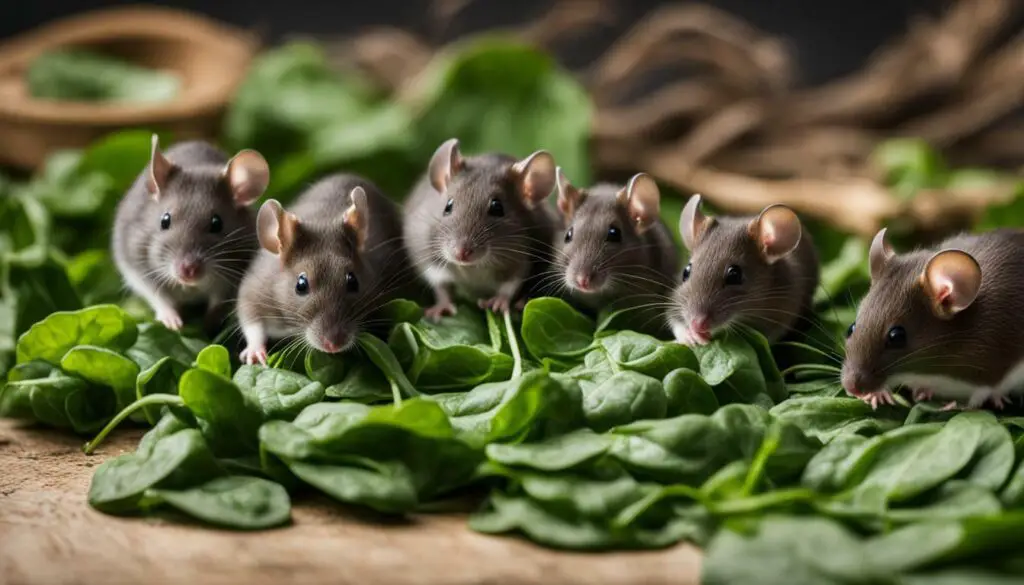
While spinach can offer nutritional benefits to mice, it’s essential to be aware of potential risks and take necessary precautions to ensure your pet’s well-being. Spinach contains oxalic acid, which can inhibit calcium absorption in mice. This can lead to issues with their bone health over time, especially if spinach is fed in excessive amounts.
It’s important to feed spinach to mice in moderation and consult a veterinarian for guidance on the quantity and suitability of this leafy green in their diet. Veterinarians can provide specific dietary advice based on your mouse’s individual needs and overall health.
To mitigate any risks, consider incorporating a variety of leafy vegetables into your mouse’s diet. This way, they can still receive the nutritional benefits of different greens without solely relying on spinach. Other options to consider include kale, cabbage, watercress, parsley, and lettuce.
| Quantity | Suitable | Risk Level |
|---|---|---|
| Small amounts | Yes | Low |
| Moderation | Recommended | Medium |
| Excessive amounts | Avoid | High |
Signs of Potential Issues
- Decreased appetite
- Lethargy
- Changes in stool consistency (diarrhea or constipation)
- Increased thirst or urination
By being mindful of the risks and following proper guidelines, you can safely incorporate spinach into your mouse’s diet. Remember, moderation is key, and consulting a veterinarian will help ensure your pet’s nutritional needs are met.
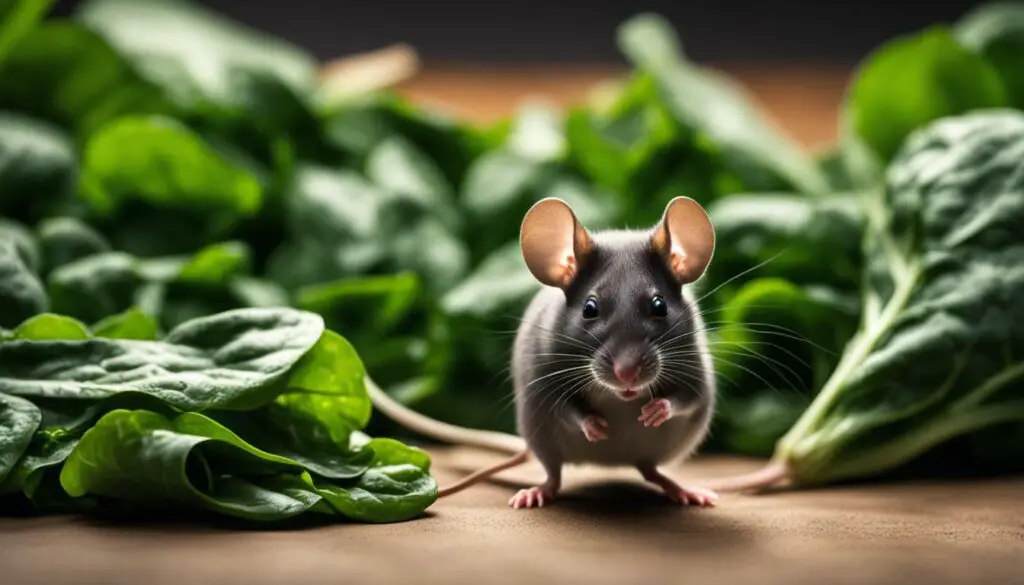
Incorporating Spinach into a Varied Diet
To provide your pet mouse with a diverse and nutritious diet, consider incorporating spinach alongside other suitable foods to create a balanced meal plan. Spinach is a leafy vegetable that offers several health benefits for mice, thanks to its rich nutritional content. It contains vitamins A, K, C, and E, which play vital roles in supporting their immune system, bone health, and overall well-being. Additionally, spinach provides important minerals like iron, manganese, zinc, potassium, and calcium, promoting a healthy diet for your mouse.
When introducing spinach into your mouse’s diet, it is essential to start gradually and monitor their response. Some mice may take time to adjust to new foods, so patience is key. You can offer small pieces of spinach leaves alongside their regular food, observing any adverse reactions or gastrointestinal issues. If your mouse shows any signs of discomfort, it’s crucial to consult a veterinarian for guidance.
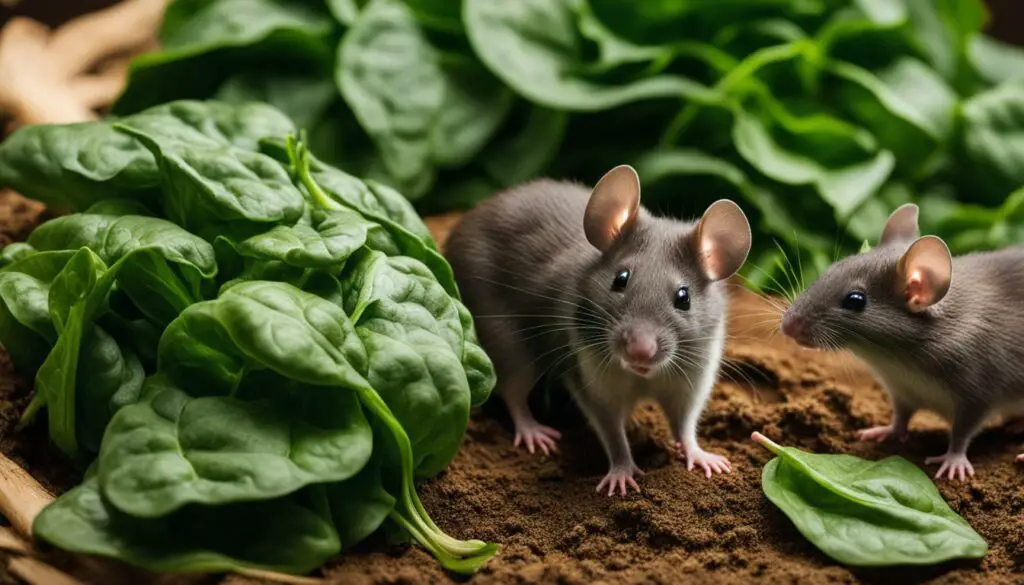
While spinach is a nutritious food for mice, it should be fed in moderation. Excessive quantities of spinach can lead to health problems, such as kidney issues, dehydration, and diarrhea. It is best to consult a veterinarian to determine the appropriate amount of spinach to include in your mouse’s diet. They can provide expert advice based on your pet’s specific needs, ensuring a well-rounded and healthy meal plan.
Aside from spinach, there are other leafy greens that mice can enjoy. Kale, cabbage, watercress, parsley, and lettuce are all suitable alternatives that offer similar nutritional benefits. These vegetables can be rotated to provide variety in your mouse’s diet, ensuring they receive a wide range of nutrients. Remember to introduce new foods slowly and observe how your mouse responds to each one.
Understanding Your Mouse’s Dietary Preferences
Just like humans, mice can have different dietary preferences, so it’s essential to observe your pet’s response to spinach and other foods to create a diet tailored to their preferences. Some mice may enjoy the taste of spinach and readily incorporate it into their diet, while others may show a preference for different leafy greens.
To better understand your mouse’s dietary preferences, start by introducing small amounts of spinach alongside other vegetables. Observe how your mouse reacts to the different options and take note of their preferences. You may notice that your mouse eats more of certain vegetables or shows a preference for specific textures or flavors.
Incorporating variety into your mouse’s diet is also important. While spinach is a nutritious option, it should be balanced with other vegetables to ensure your mouse receives all the necessary nutrients. Consider offering alternative leafy greens like kale, cabbage, watercress, parsley, and lettuce to provide a diverse range of nutrients and flavors.
| Vegetable | Nutritional Benefits |
|---|---|
| Spinach | Rich in vitamins A, K, C, and E, as well as iron, manganese, zinc, potassium, and calcium |
| Kale | High in vitamins A, C, and K, and a good source of calcium and iron |
| Cabbage | Contains vitamins C and K, as well as dietary fiber |
| Watercress | Packed with vitamins A and C, calcium, and iron |
| Parsley | Rich in vitamins A, C, and K, as well as iron and calcium |
| Lettuce | Contains vitamins A, C, and K, and is a good source of dietary fiber |
Remember to introduce new vegetables gradually into your mouse’s diet and consult a veterinarian for advice on the quantity and suitability of foods like spinach. They can provide personalized guidance based on your mouse’s individual needs and help you create a well-rounded and healthy diet plan.
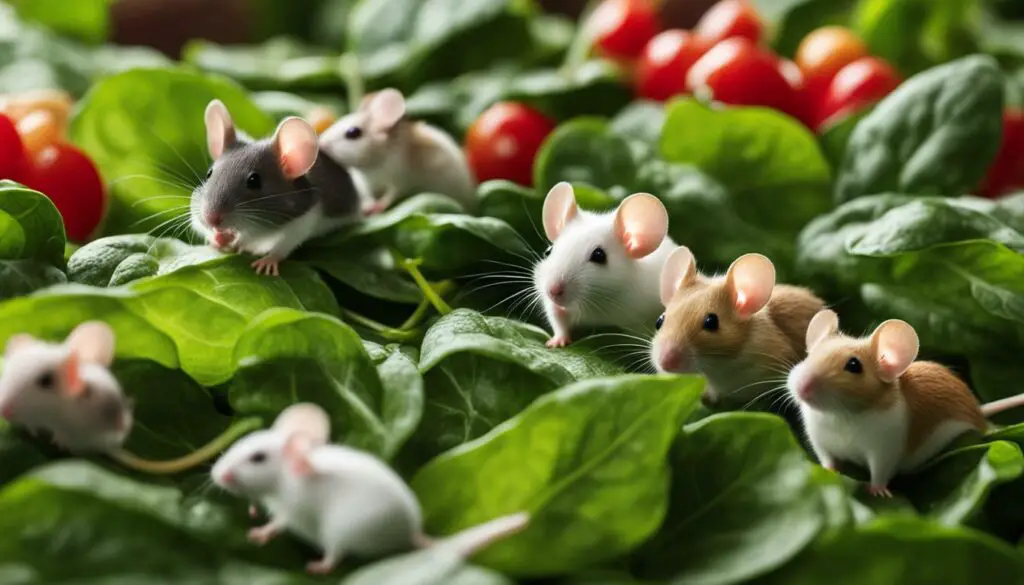
Incorporating spinach into your pet mouse’s diet can have a positive impact on their health and well-being by providing essential nutrients to support their overall bodily functions. Spinach is rich in vitamins A, K, C, and E, which are important for maintaining a healthy immune system, promoting proper blood clotting, and supporting healthy eyes and skin.
This leafy green vegetable is also a good source of minerals such as iron, manganese, zinc, potassium, and calcium. Iron plays a vital role in the production of red blood cells, while manganese and zinc contribute to bone health and the proper functioning of enzymes in the body. Potassium helps regulate blood pressure and supports heart health, and calcium is essential for strong bones and teeth.
By including spinach in your mouse’s diet, you can provide them with a variety of essential nutrients that contribute to their overall well-being. However, it is crucial to feed spinach in moderation. Excessive amounts of spinach can lead to health issues such as kidney problems, dehydration, and diarrhea. It’s always best to consult a veterinarian for guidance on the quantity and suitability of spinach in your mouse’s diet.
| Nutrient | Benefit |
|---|---|
| Vitamin A | Supports immune function and healthy eyes |
| Vitamin K | Promotes proper blood clotting |
| Vitamin C | Boosts immune system and contributes to healthy skin |
| Vitamin E | Protects cells from oxidative damage |
| Iron | Aids in red blood cell production |
| Manganese | Supports bone health and enzyme function |
| Zinc | Contributes to bone health and enzyme function |
| Potassium | Regulates blood pressure and supports heart health |
| Calcium | Essential for strong bones and teeth |
Remember to introduce vegetables gradually into your mouse’s diet and monitor for any adverse reactions. Each mouse may have individual dietary preferences, so it’s important to observe their preferences and adjust their diet accordingly. By providing a well-rounded and varied diet that includes spinach and other suitable vegetables, you can help ensure that your pet mouse receives the necessary nutrients for optimal health.

Disclaimer: The information provided in this article is for informational purposes only and should not be considered as veterinary advice. Always consult a veterinarian for specific dietary recommendations and guidance tailored to your pet mouse’s individual needs.
Conclusion
In conclusion, mice can safely eat spinach as part of a balanced diet, but it should be offered in moderation. While spinach provides numerous nutritional benefits, including vitamins A, K, C, and E, as well as minerals like iron, manganese, zinc, potassium, and calcium, overfeeding spinach to mice can lead to health issues such as kidney problems, dehydration, and diarrhea.
It’s important to remember that mice have individual preferences when it comes to their diet. Some mice may enjoy spinach, while others may prefer alternative leafy vegetables like kale, cabbage, watercress, parsley, or lettuce. Slowly introducing vegetables into a mouse’s diet and observing for any adverse reactions is key.
To ensure your mouse’s optimum health, it is highly recommended to consult a veterinarian for professional guidance. Veterinarians possess the expertise to create a well-rounded and tailored diet plan for your pet mouse, taking into consideration their specific needs and dietary requirements. They can provide valuable advice on the quantity and suitability of foods like spinach in your mouse’s diet.
FAQ
Can pet mice eat spinach?
Yes, pet mice can eat spinach as part of their diet.
What are the nutritional benefits of spinach for mice?
Spinach is rich in vitamins A, K, C, and E, as well as minerals like iron, manganese, zinc, potassium, and calcium, which are nutritious for mice.
How much spinach should I feed my mice?
It is important to feed spinach to mice in moderation to avoid health issues such as kidney problems, dehydration, and diarrhea. Consult a veterinarian for guidance on the quantity and suitability of spinach in a mouse’s diet.
Are there alternatives to spinach for mice?
Yes, mice can also eat other leafy vegetables such as kale, cabbage, watercress, parsley, and lettuce, which provide similar nutritional benefits.
How should I introduce vegetables to my mouse’s diet?
It is recommended to introduce vegetables, including spinach, slowly into a mouse’s diet to ensure they transition well and monitor for any adverse reactions.
Should I consult a veterinarian for dietary advice?
Yes, it is important to consult a veterinarian for specific dietary advice regarding spinach and other food choices for pet mice. They can help create a well-rounded and healthy diet plan.
Are there any risks associated with feeding spinach to mice?
Feeding excess spinach to mice can inhibit calcium absorption due to its oxalic acid content. Moderation is key, and consulting a veterinarian can help mitigate any potential risks.
How can I incorporate spinach into a varied diet for my mice?
It is important to offer a mix of different foods, including spinach, to ensure mice receive all the necessary nutrients for a well-rounded diet.
Should I consider my mouse’s dietary preferences?
Yes, it is important to understand your mouse’s dietary preferences and individual needs. While some mice may enjoy spinach, others may prefer different leafy greens.
What role does spinach play in supporting mouse health?
Spinach can contribute to overall mouse health by supporting their immune system, bone health, and overall well-being due to the nutrients it contains.

